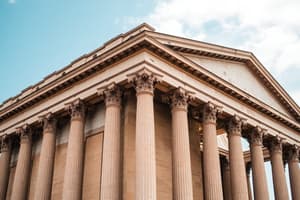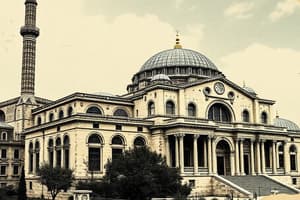Podcast
Questions and Answers
Flashcards
Who initiated the construction of the hypostyle hall at Karnak?
Who initiated the construction of the hypostyle hall at Karnak?
The founder of the 19th dynasty, Rameses I, is recognized as the beginner of the great hypostyle hall at Karnak.
How would you describe the essence of Greek architecture?
How would you describe the essence of Greek architecture?
Greek architecture primarily revolved around columnar and trabeated structures.
What material was of utmost importance to Greek architecture?
What material was of utmost importance to Greek architecture?
Marble was the cornerstone material for Greek architecture, and Greece and its territories had an abundant supply of it.
What structure marks the grand entrance to the Acropolis?
What structure marks the grand entrance to the Acropolis?
Signup and view all the flashcards
Which building on the Acropolis stands as the pinnacle of architectural excellence?
Which building on the Acropolis stands as the pinnacle of architectural excellence?
Signup and view all the flashcards
What innovation enabled the Romans to create vast interiors?
What innovation enabled the Romans to create vast interiors?
Signup and view all the flashcards
Which order did the Romans add to the Greek architectural system?
Which order did the Romans add to the Greek architectural system?
Signup and view all the flashcards
What is the defining characteristic of Byzantine architecture?
What is the defining characteristic of Byzantine architecture?
Signup and view all the flashcards
What material distinguishes Romanesque architecture in Italy?
What material distinguishes Romanesque architecture in Italy?
Signup and view all the flashcards
Which Roman structure is considered the most remarkable and intact ancient building?
Which Roman structure is considered the most remarkable and intact ancient building?
Signup and view all the flashcards
What is the name given to the space between the columns and the temple's inner chamber?
What is the name given to the space between the columns and the temple's inner chamber?
Signup and view all the flashcards
What was the primary purpose of amphitheaters?
What was the primary purpose of amphitheaters?
Signup and view all the flashcards
What was the purpose of a Stoa in ancient Greece?
What was the purpose of a Stoa in ancient Greece?
Signup and view all the flashcards
What is the fortified high area or citadel of an ancient Greek city?
What is the fortified high area or citadel of an ancient Greek city?
Signup and view all the flashcards
What are the upright ornaments at the eaves of a tiled roof?
What are the upright ornaments at the eaves of a tiled roof?
Signup and view all the flashcards
What are the ornaments at the corners or peak of a roof called?
What are the ornaments at the corners or peak of a roof called?
Signup and view all the flashcards
What ornamental design, often called 'honeysuckle,' was popular in ancient Greece?
What ornamental design, often called 'honeysuckle,' was popular in ancient Greece?
Signup and view all the flashcards
What was the purpose of an 'Apotheca' in ancient Greece and Rome?
What was the purpose of an 'Apotheca' in ancient Greece and Rome?
Signup and view all the flashcards
What was a core element in the decorative scheme of Greek architecture?
What was a core element in the decorative scheme of Greek architecture?
Signup and view all the flashcards
What space serves for communal dining in a religious or educational institution?
What space serves for communal dining in a religious or educational institution?
Signup and view all the flashcards
What is architecture of the curved line known as?
What is architecture of the curved line known as?
Signup and view all the flashcards
What open courtyard is commonly found within an Italian palazzo?
What open courtyard is commonly found within an Italian palazzo?
Signup and view all the flashcards
What is the ornamental pattern work in stone found in the upper part of a Gothic window?
What is the ornamental pattern work in stone found in the upper part of a Gothic window?
Signup and view all the flashcards
What architectural term refers to a 'cubicula' or bedroom?
What architectural term refers to a 'cubicula' or bedroom?
Signup and view all the flashcards
How many stained glass panes are there in Chartres Cathedral?
How many stained glass panes are there in Chartres Cathedral?
Signup and view all the flashcards
What are the parts of an entablature, in order from top to bottom?
What are the parts of an entablature, in order from top to bottom?
Signup and view all the flashcards
What is the plan shape of a Chinese pagoda?
What is the plan shape of a Chinese pagoda?
Signup and view all the flashcards
What is the usual number of stories in a Chinese pagoda?
What is the usual number of stories in a Chinese pagoda?
Signup and view all the flashcards
What shape distinguishes a Japanese pagoda from a Chinese one?
What shape distinguishes a Japanese pagoda from a Chinese one?
Signup and view all the flashcards
What is the triangular piece of wall above the entablature?
What is the triangular piece of wall above the entablature?
Signup and view all the flashcards
What is the name given to the spherical triangles that connect a dome to its base?
What is the name given to the spherical triangles that connect a dome to its base?
Signup and view all the flashcards
What is the long, arcaded entrance porch in an early Christian church?
What is the long, arcaded entrance porch in an early Christian church?
Signup and view all the flashcards
What is the central part of a church, extending from the narthex to the choir or chancel?
What is the central part of a church, extending from the narthex to the choir or chancel?
Signup and view all the flashcards
What is the name of the uppermost step in the crepidoma?
What is the name of the uppermost step in the crepidoma?
Signup and view all the flashcards
What is the name of the lowest step in the crepidoma?
What is the name of the lowest step in the crepidoma?
Signup and view all the flashcards
Study Notes
History of Architecture Reviewer Summary
- Early Architecture: The beginner of the great hypostyle hall at Karnak was Rameses I. Marble was the most important mineral for Greek architecture. Greek architecture was primarily columnar and trabeated. The Propylaea, the Parthenon, and the Composite order were key structures and additions during this time.
Roman Architecture
- Materials and Techniques: Romans used concrete, making it possible to build large interiors and use arches and vaults. They added the Composite order, extending upon Greek architectural styles. Romanesque architecture in Italy used marble for facing walls. The Pantheon is a famous example of a perfect presentation of Roman architecture.
Byzantine Architecture
- Domical Roof Construction & Materials: Byzantine buildings often featured the use of domical roofs and generally used marble.
Other Architectural Styles
- Greek & Roman Architecture: Components like the pteroma (the space between columns and naos in Greek temples), stoas (ancient Greek porticoes), acroteria (pedestals or ornaments at the edges of roofs), anthemion, apotheca(storerooms) and other forms were features of both Greek and Roman architecture. Byzantine architecture used a domical roof construction.
- Early Christian Architecture: There was a space in early Christian churches (often semi-circular or semi-polygonal) called the Apse, for use as an altar.
- Terms & Terminology: Terms discussed include the Refectory (dining hall in a monastery or college), cubicula (Roman bedrooms), tracery (ornamental pattern work), and others.
- Architectural elements: Aspects like Pediments, Pendentives, Narthex, Nave and different styles of plans and shapes of architecture were also explained.
- Specific Buildings and Architects: Details about specific buildings (e.g., Chartres Cathedral, the Pantheon, Colosseum) and the architects involved (e.g., Ictinus, Callicrates, Imhotep) were included. Architect's plans and contributions are highlighted.
Architectural terms and styles
- Styles explained: Styles such as Baroque, Roman, Gothic, Greek and others, and how these evolved into other modern or contemporary styles were categorized.
- Key Architectural Elements: Individual elements of buildings like columns, arches, vaults, and domes, and their importance were discussed.
- Architectural Elements & Terminology: Definitions included Acroterion, Anthemion, Pilaster, Baluster, Vault, Bay Window, Pediment, Plinth, and many more.
- Famous Architectural works: Analysis and description for specific architectural works from different time zones were included like the Colosseum, Parthenon, etc.
Studying That Suits You
Use AI to generate personalized quizzes and flashcards to suit your learning preferences.




